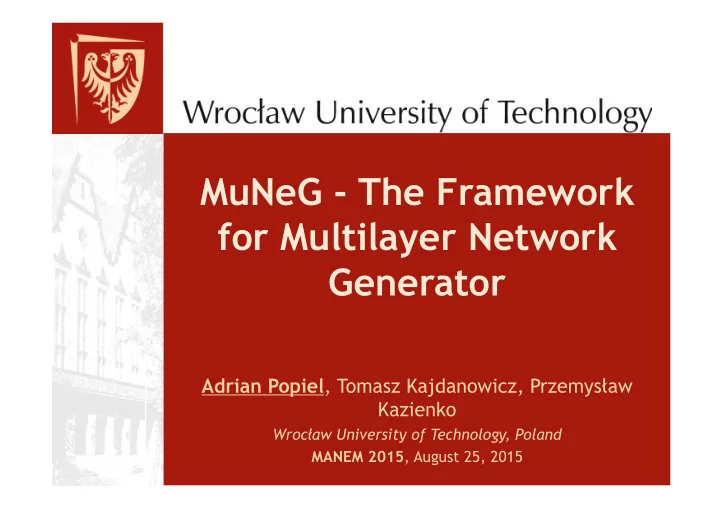

MuNeG - The Framework for Multilayer Network Generator Adrian Popiel , Tomasz Kajdanowicz, Przemys ł aw Kazienko Wroc ł aw University of Technology, Poland MANEM 2015 , August 25, 2015
Slide 2/25 Outline • Uniplex and multiplex networks • Network models • Network properties • Multiplex network generation • Behind MuNeG • Experimental setup • Results • Conclusions
Slide 3/25 Uniplex and multiplex networks •
Slide 4/25 Uniplex and multiplex networks(2) •
Slide 5/25 Uniplex and multiplex networks(3)
Slide 6/25 Network models • Random graphs(Erd ő s-Rényi model) – Edge existence comes from binomial distribution • Configurational model – Takes degree distribution as an input • Small worlds(Watts and Strogatz) – Uses node degree as input • Scale-free networks(Barabási-Albert) – Networks with power-law distribution
Slide 7/25 Properties of a network • Node degree • Maximum node degree • Number of edges • Clustering coefficient • Number of triangles • Average shortest path • Diameter
Slide 8/25 MuNeG • Version 1.0 is released – https://github.com/Adek89/MuNeG/releases/ tag/1.0 • Generator is still in development – Version 1.1-SNAPSHOT: https://github.com/ Adek89/multiplex/tree/master/MuNeG
Slide 9/25 Main goal of MuNeG • Generate multiplex networks for a collective classification • Enhance network models to domain of multiplex networks • Generate networks with expected properties • Generate networks similar to real data • Check if generated networks are similar to existing network models
Slide 10/25 Real data properties ( Newman, Mark EJ. "The structure and function of complex networks." SIAM review 45.2 (2003): 167-256.) Network Number of Mean node Clustering Mean domain and nodes degree coefficient distance name between nodes Social – 573 1.66 0.005 16.01 student relationships Information – 1022 4.99 0.13 4.87 Roget’s Thesaurus Technological 10697 5.98 0.035 3.31 - Internet Biological – 2115 2.12 0.072 6.80 protein interactions
Slide 11/25 MuNeG algorithm – input parameters •
Slide 12/25 MuNeG algorithm - groups •
Slide 13/25 MuNeG algorithm – homophilly and edge existence •
Slide 14/25 Experiments
Slide 15/25 Experiments - parameters •
Slide 16/25 Experiments - calculations •
Slide 17/25 Results – node degree
Slide 18/25 Results – node degree
Slide 19/25 Results - clustering
Slide 20/25 Results - clustering • Clustering is relatively big • Average transitivity inside groups tends to be very high
Slide 21/25 Results – average shortest path
Slide 22/25 Results – average shortest path
Slide 23/25 Conlusions •
Slide 24/25 Future work • Algorithm improvements: – API to generate networks similar to real – API to generate mulitplex networks similar to known network models • Each layer should represent uniplex network similar to known models or real data • https://github.com/Adek89/multiplex/ tree/master/MuNeG
Slide 25/25 Thank you!
Recommend
More recommend